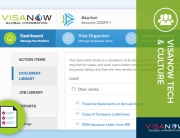
Recently we talked about the visa waiver program and how it facilitates movement and temporary migration for certain foreign citizens traveling to the U.S. Similar to the visa waiver program, Europe’s Schengen Visa facilitates international travel for citizens of designated countries. The Schengen Visa is convenient because it allows travelers access to 26 European countries at once with only one point of entry.
Origins of the Schengen Visa
Originally implemented by Belgium, France, Germany, Luxembourg, and the Netherlands in 1985, the Schengen Borders Agreement promotes free movement, European unity, and international collaboration by lessening border controls within an area that contains nearly 5,000 miles of land boundaries. Named after the town in Luxembourg where it was signed, the Schengen agreement abolished many of the checks in place at border areas throughout Western and Central Europe. Almost 30 years later, the Schengen Area contains 26 countries. Four more European Union member countries are legally bound to join the Schengen area in the near future. The United Kingdom and Ireland have opted out of the Schengen agreement due to their concerns that island countries have different needs and expectations when managing their international borders.
The Schengen visa is the name given to the travel visa needed to visit anywhere in the Schengen Area. Once a foreign citizen has obtained his or her Schengen visa, he or she can move freely throughout the Schengen Area without worrying about multiple checks at customs and border patrol.
Do United States citizens need a Schengen Visa?
If you are a U.S. citizen with a valid passport who is traveling for business or tourism, you do not need to apply for the Schengen Visa. The United States, Australia, Japan, Canada, and many other North and South American countries have visa-free access to the Schengen Area for up to 90 days at a time. Asian and African countries tend to have the most restrictions to the Schengen area, which means they require a Schengen Visa. See a map of the Schengen Visa restrictions by country here.
Schengen Visa Restrictions
Like the U.S. travel visa, activities on the Schengen Visa are mostly limited to business trips and tourism. One of the most important rules for Schengen visitors to remember is the restriction on time. 90 days is the maximum amount of time a traveler is allowed in the Schengen Area within a 180 day period. This applies even if a citizen hails from a visa-free country like the United States. Your passport must be valid for at least 90 days after your arrival in the Schengen Area or you will not be admitted. You may apply to readjust your visa status while in the Schengen area if you wish to stay longer than 90 days.







